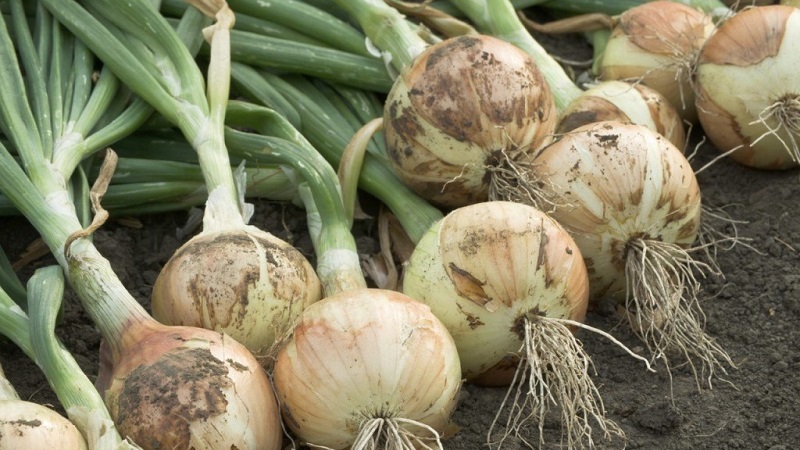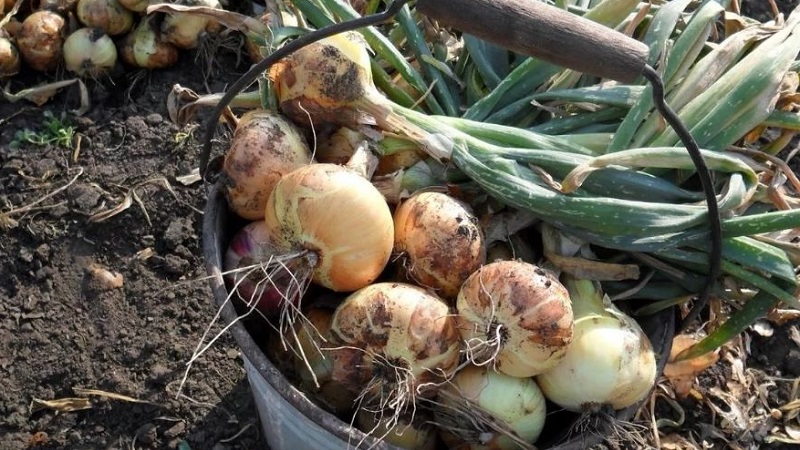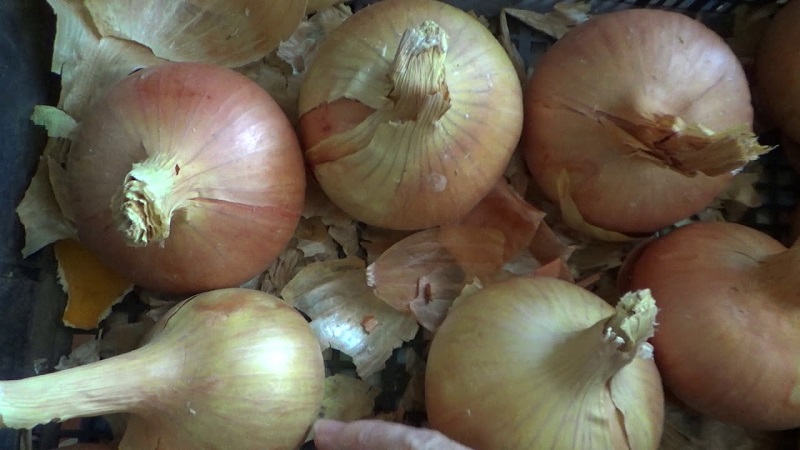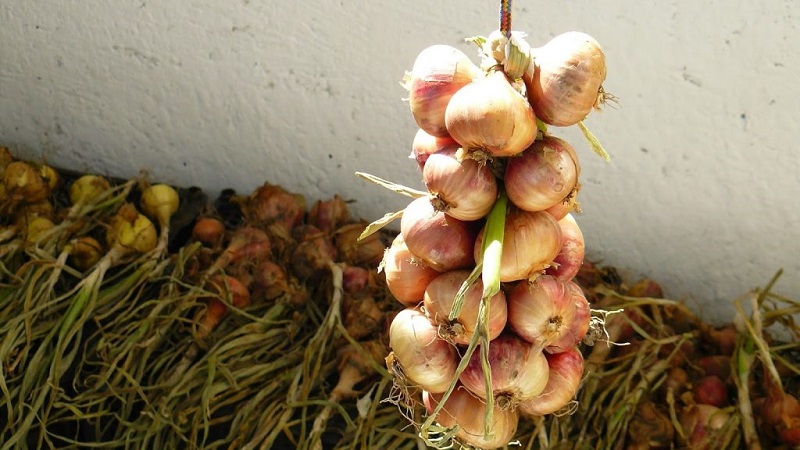Why cut onions, and how to do it correctly for storage for the winter
After harvesting the onion, it is important to properly prepare it for long-term storage. One of the mandatory steps is trimming the feathers. The procedure allows you to keep vegetables fresh almost until spring, protects them from rot.
The content of the article
How to understand that the onion is ripe
Onions fully ripen in the first half of August, but the timing varies slightly depending on from the region and climatic conditions. For long-term storage of the crop, it is important not to overripe vegetables or dig them up prematurely.
The approximate time for picking vegetables is about 80 days from the date of planting, if not an early variety was planted.

If the husk has not yet fully formed, the bulbs will quickly start to rot even at the right temperature and humidity. On late harvested vegetables, dry scales practically do not hold, they quickly crumble, roots germinate. In overripe specimens, excessive wateriness appears, the pungency and richness of taste are lost. It is better to use such onions right away or use them for preservation, but do not leave them for storage.
Signs
The main sign of ripe vegetables is dried and yellowed tops.... She weakens and sinks completely to the ground. By the time of harvest, the bulbs are saturated with nutrients as much as possible.
Reference! It is not always correct to focus on the yellowed and lodged tops: feathers do not fall in rainy and cool summers.
Reliable outward signs of bulb ripening:
- thinning and drying neck;
- some of the dry scales peeking out of the ground do not peel off and look dry.

If the tops have not turned yellow before the planned harvesting, they are not immediately cut off.... The bulbs are left under a canopy for 15–20 days: during this time, the feathers dry out, and all the nutrients go to the turnips.
It can be useful:
Very early and cold-resistant salad type of onion "Ellan"
How to properly harvest onions
A dry sunny day is chosen for harvesting... For 10-14 days, watering is stopped to increase the keeping quality of vegetables. In case of prolonged rains, the area is covered with a waterproof material so that the onions do not dry for a long time.
By the way! On peat or sandy soil, turnips are easily pulled out, and on dense loamy soil they often remain without bottoms and quickly rot.
Onions are harvested in the morning, pulled out of the ground, left on the garden in even rows for preliminary drying... In the evening, they are transferred to a shed or other room with good ventilation for 2-3 days. After that, the remains of the soil are removed from the vegetables, the root part is cut off to the very bottoms.
High-quality drying is the key to long-term storage... If the bulbs are left wet, mold will quickly spread and rot.

Why cut onions
Cropping is useful from a practical point of view: Without dried feathers, vegetables take up less space, look neater, more attractive to customers. The remaining feathers often begin to rot - the fungus is transferred to the turnips, as a result, the crop quickly disappears.
When pruning, it is important not to damage the tops, otherwise bacteria will get into the bulb itself... Some gardeners leave feathers to braid for long winter storage.
Preparation and pruning
After collecting from the garden and drying, all vegetables are carefully examined, sorted... Affected specimens are discarded or consumed first.They are not suitable for storage.
How to properly trim onions
For storage for the winter, feathers are removed in such a way that the husk of the turnip is not damaged.... If the tops are dry and stretch well, they are cut off by hand, leaving the leg no more than 5 cm long. If the bulb has a large thick neck, about 8–10 cm is left at the base, but such specimens deteriorate before anyone else. To store the crop in "pigtails", the neck is left up to 15 cm.
Important! If the onion is harvested for more than 3 months, the cut site is treated with lime paste. This will reduce the risk of rot or sprouting.
How to cut a set
Planting material is not consumed, but stored until next seasonto grow full-fledged turnips. The harvesting and storage of onion sets is somewhat different from the usual ones; pruning also becomes more laborious due to the size of the vegetables.

Cut off the feathers immediately after the seed is removed from the soil... The root part is not removed, but only cleaned of soil residues. The tops are cut 10 cm from the base. During pruning, they immediately carry out rejection, removing damaged specimens from the total mass.
When not to prune
Sometimes pruning onions is completely useless.... So, some summer residents use dry tops for bundling instead of rope. Rotten or damaged specimens are removed from the total mass of the crop to prevent damage to the rest. Previously, vegetables are laid out in the open sun on the site for 10-12 hours.
How to dry properly
Drying turnip and sevka prevents rotting... In dry weather, the crop is laid out on open beds, plywood sheets or boards, and in case of rain - in a well-ventilated room, on sackcloth or a layer of paper. Vegetables are kept in the sun for 10-15 days.
Onions are also stored in braids, if it is not possible to lay them out in layers... They hang it in dry ventilated rooms (in a barn, on a veranda, an attic). After complete drying, the braids are tied up again, removing the damaged specimens.
Read also:
Winter storage
The choice of a place for onions is determined taking into account the possibilities and volume of the crop. It is much easier for owners of private houses or garages to solve this problem than for apartment owners.
Main conditions:
- cleanliness of the room and the selected container;
- temperature - within 0 ° C;
- air humidity - 65-75%;
- regular ventilation and good ventilation.
It is allowed to store onions at a temperature of -2 ... -3 ° C, but without hesitation... In such conditions, vegetables are suitable for consumption for 8-10 months.

Where and how to store
Convenient to keep onions in a cellar or basement... This is done in several ways:
- in bulk (in one bulk up to 3 m high on pallets made of boards or on shelves with holes for ventilation);
- in wooden boxes covered with bags or blankets;
- in a net and bags;
- in the form of bundles.
If the room has poor thermal insulation, then in severe frosts, the crop is covered with blankets and straw. The main thing is that the material allows air to pass through.
At home
Apartments have much less conditions for placing crops. One of the storage options is a refrigerator, but in it vegetables retain their freshness and taste only up to 1.5 months. The best place is the lower shelves or drawers for vegetables. The bulbs are not tied tightly in plastic bags, otherwise condensation will form. It is enough to arrange them in bulk or in paper bags.
Important! Onion rots quickly on the upper shelves of the refrigerator, a specific smell appears.
On balconies with insulation, where the temperature does not exceed + 7 ° C and does not fall below 0 ° C, vegetables are laid out in boxes or bowls... Such containers are not placed next to potatoes: they actively release moisture, which leads to rapid damage to the crop.
Conclusion
Onions grown during the season successfully retain their presentation and taste throughout the entire autumn-spring period.It is important to properly collect vegetables from the garden, dry them properly and cut them off to protect them from rotting, loss of taste and nutritional qualities. Removing feathers extends the shelf life of the crop and provides the family with a useful product until the next season.